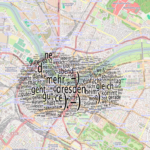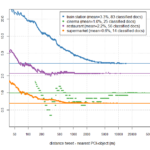In contrast to photo-based VGI (e.g. Flickr) the correlation between the place where an information has been created and what the information is about is less intuitive for text-based VGI. In order to gain more insight into the relationship between text information generated in mobile contexts (e.g. via smartphones) and their recorded location, research has been conducted using the example of of microblogging texts (tweets) produced on mobile devices.
For the purpose of this research, tweet topics were correlated to areas. In doing so, classified points of interest from OpenStreetMap served as validation points. The classification and geolocation of these points was adopted to correlate with tweet content by means of manual, supervised, and unsupervised machine learning approaches. Evaluation showed the manual classification approach to be highest quality, followed by the supervised method, and that the unsupervised classification was of low quality.
Regarding the initial research goal, it was found that the degree to which tweet content is related to nearby points of interest depends upon topic (that is, upon the OpenStreetMap category). A more general synthesis with other research leads to the conclusion that the strength of the relationship of tweets and their geographic origin also depends upon geographic scale of the respective analysis, where correlations found by large scale analyses are more significant than those found by small scale analyses. This finding highlights the crucial importance of considering scale in Twitter analyses. This has also been highlighted in another recent article from our group (multi-scale nature of the Twitter dataset). Moreover, events and also photos included in the microblogging-texts seem to increase the location-content correlation.
In the scope of this research we are happy to announce a paper that has recently been published open access in the Journal of Spatial Information Science (JOSIS).
References:
Hahmann, S., Purves, R.S. & Burghardt, D. (2014): Twitter location (sometimes) matters: Exploring the spatial relationship between georeferenced Tweets and feature classes, Journal of Spatial Information Science. iss. 9, pp. 1–36
Hahmann, S. (2014): Zur Beziehung von Raum und Inhalt nutzergenerierter geographischer Informationen. PhD thesis (in German), TU Dresden.





